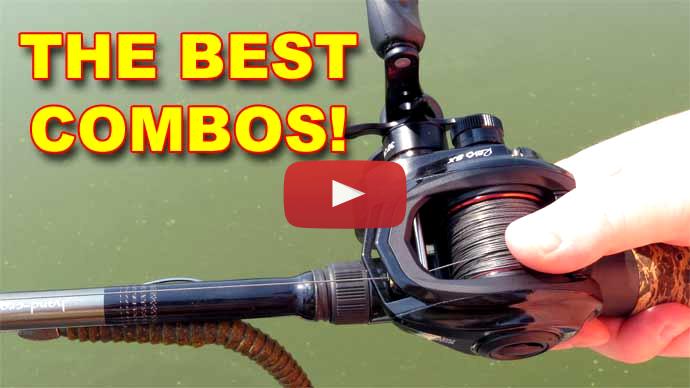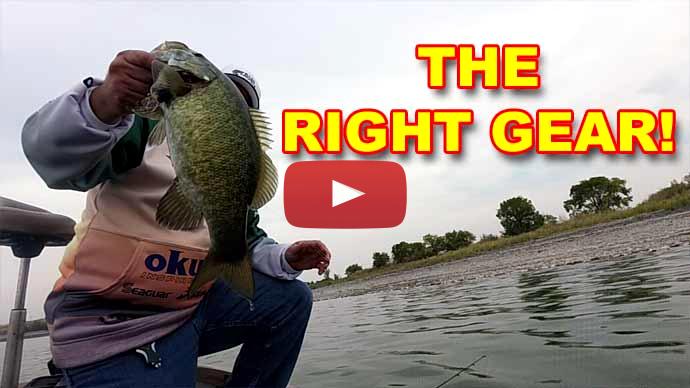Keri: Out deep. Barely felt him bite that. I mean, I barely felt him bite that. Come here. Come, Hither. Come, Hither. You're a little football. Dear Lord. I'm playing keep-away with myself again. Dear Lord, you're a little football. There you are.
Glenn: It's a good fish.
Keri: He's a little chunk. He's got a thick back to him. He's been doing well.
Glenn: Yeah.
Glenn: Hey, folks. Glenn May here with BassResource.com. And today, I want to talk to you about the five most common rod and reel setups that's gonna cover almost all of your bass fishing.
Now, you know, if you've noticed the trend that's happened lately in equipment is that you get a lot of rod and reel technique-specific equipment out there, right? You can get a drop shot rod, a drop shot reel, for example, or a worm rod and a worm reel.
While these actually do an excellent job for that specific technique, you don't have to run to the store and buy all these different combos for each technique. Not only is that not feasible, it's not economically viable. And if you're a bank angler, or a kayak angler, or you're bassing, or a backseat angler, you just can't carry around that much equipment. Let's face it, right, even if you had the money.
So instead, I want to tell you about these five combos that will cover almost any situation, and it's going to save you some money, and it's going to enable you to consolidate your equipment and focus more in fishing.
So let's start off with an easy one. Oh, wait. Before I get into that, one of the things I want to mention, I want to give you a little caveat here. Rod and reel manufacturers out there, there's no set standards. It's kinda like clothing companies. One company's extra-large is someone else's large. Someone else has a long sleeve on their medium whereas some other company's medium is way too short for you. Or it's too tight around the waist or what have you. Right, it's different for every manufacturer.
Well, bass fishing is no different. So, yeah, a rod may be 7 foot 2 inches, you would think that would be a standard. Well, it kind of depends on where the reel seat's situated. Some of these have longer reel handles because the reel seats moved up further. Well, if that's the case, that means it's shorter from the reel seat forward to the tip of the rod. And vice versa. Some guys really like long rod handles, and that's why they do that. Others like shorter rod handles. So there's a fit that goes with it.
Also with some rod manufacturers, their medium heavy is another manufacturer's heavy. And some other manufacturer's heavy is someone else's moderate. It can be all around the board.
So what I'm telling you here is that these combinations I'm about to tell you about, if you land somewhere near them but really try out the different brought rods and reels, you're going to come close enough to match what I'm talking about. And it's the same thing with the reels. The gear ratios, manufacturers of 6.1 to 1 gear ratio could be another 6.5 to 1 gear ratio. So everything's kind of approximate, what I'm about to tell you.
Oh, and one other thing, your height. The taller you are, the longer the rods tend to be. They're a little bit easier to handle, the taller you are. Now someone... I'm short, I'm under 6 feet. Those 7 foot 11 rods are a bit unwieldy. I have one, I tried it for a flipping stick and it's just a little too...you know, it's heavy on my arm and I hit, you know, the console, I'm hitting the fish finder. Sometimes I hit the water, it's just too long for me, right? But if you're a guy who's 6 foot 6, it may be a perfectly suitable rod for you. So just kind of keep that in mind, your stature as well as your personal preferences are going to play a role. So with all that caveat in mind, let's start right off.
Easiest one is a 7-foot medium-heavy fast-action rod. That's like the main rod and reel that you get, it's the first rod you ever get for bass fishing. This is the one to get because it's so versatile. You can use it for worms, you can use it for jigs, you can use it for spinnerbaits, you can throw buzzbaits with it, topwater, so on and so forth. It's a very versatile and flexible rod.
Pair with that, you want a kind of medium gear ratio, so like a 7.4 to 1 gear ratio. That way, you can slow roll spinnerbait or bring it back fast if you want or any other lure. The speed's right in the middle. Just by slowing down, you're cranking or speeding it up, you can control that lure.
The line, I would throw in a 15-pound fluorocarbon line. Personally, I like to use Seaguar Invizx because that is sort of the universal line. Fluorocarbon can be used anywhere. And I know a lot of you guys think braid is the answer and braid is universal. It's not. Braid is not as flexible as people think it is. For one, braid doesn't do as well in rocks as fluorocarbon. Braid tends to get scuffed up, it gets nicks, it gets sprayed a lot easier than fluorocarbon. Fluorocarbon can be thrown in wood, rock, weed everywhere, and come out pretty good.
And Seaguar Invizx is real supple. It's castable, so you can throw a spinnerbait with it and you can throw buzzbaits with it. It's also really good in weeds. So you can throw jigs, worms, whatever.
So that is a universal setup right there. That is you can cover so much with just that. I've got four rods like that in my rod locker, just to give you an idea, each tied with something different. That's how versatile this setup really is.
The next one is another versatile setup, and this is for spinning is a 7-foot medium-power moderate-action rod, sometimes it's called a light action rod. This is a setup for virtually all finesse tactics. You can throw drop shot, split shot, tubes, grubs, finesse jigs, any kind of...and even, light, crankbaits light topwater.
Pair that with a size 2,500 spinning reel. Some manufacturers call them a size 20, some of them a size 30. You don't want to go below that smaller because the reel is too small, you don't have a much drag surface for one. But also you got a lot of coil problems with angle line twist. And when it's too big it's just too heavy and unwieldy for finesse tactics. So right in that mark is what you want.
The key thing with that is a nice smooth drag. Because with finesse tactics, you're using small hooks. So a drag that's really smooth and has a lot of give to it helps play that fish out when he runs, that rod, it's got the parabolic action to it. That's why you want a medium-power rod. So it's got some give to it. When the fish runs, it bends, slows the fish down, and then the drag kicks in and helps slow that fish down. Everything works together, so you're not pulling a hook out of a fish's mouth.
The line I use is a 6-pound fluorocarbon line. Again, I like to use Tatsu. All right? Seaguar Tatsu line. That's super supple, super sensitive. But because it's so sensitive, it allows the bait to move on its own. It doesn't impede that action of that bait at all.
And, you know, a lot of people like to use braid. Braid has no give to it. You got those little, tiny hooks, that braid is going to enable that hook to be pulled out of a fish's mouth. Fluorocarbon has a little give to it, a little bit of stretch. Some people overestimate how much stretch fluorocarbon has. It doesn't have a lot. But it does have a little more give than braid. And all that works in concert with the rod and reel in order to play that fish out with that light line technique. So that is the perfect thing that you want to use, right, for all kinds of finesse tactics.
Next, rod and reel. This one's really the only technique-specific rod and reel I would get to and use that I'd recommend out of these five, and that's a crankbait rod. Here would be a 7'2" to 7'4" medium-power moderate-action rod, maybe fast action rod, that's designed for crank baiting. And the reason why you want to do that is a couple of things.
First of all, crankbaits have those little, teeny treble hooks. There's a small bite to them. And they're thin wire. Again, just like in finesse fishing, they can get pulled out of the fish's mouth if you've got too stout of equipment. So that rod has...that parabolic rod has basically a big spring. Helps slow that fish down when he takes a run for it and absorbs a lot of that shock.
Also with that rod, the way it bends and is flexible, it enables you to throw those lures out really far, long casts. And that is key to crankbait fishing. The further out you can get it, the faster you can get it down to its running depth, and the longer it's going to stay down there before it starts coming back up to you. And the key to catching a lot of fish in crankbait is getting it down to that running depth and keeping it down there. So those long casts are critical to that. So that rod's gonna enable you to make really long casts
Paired with it is a reel that the key thing is having a real smooth drag on it. And that's because, again, those treble hooks. If you're pulling that drag and you tighten it down and that line is going tick, tick, tick, tick, tick, tick, it's doing that, well, each time it pops, it's pulling that hook out a little bit more every time. And you can end up losing fish with a sticky drag. A real smooth drag kind of acts as a parachute. It'll slow that fish down and help you turn them around and absorb a lot of that, especially when they run. It's going to keep them pinned and keep that hook from coming out.
The line I like to use is 12-pound fluorocarbon line. I like to use Seaguar Tatsu line in this instance because you can cast a country mile with it, first of all. It's a great castable line. Plus, the thin diameter enables that lure to get down to its running depth. And fluorocarbon actually is a little bit denser, has a little bit of weight to it. So it kind of sinks down a bit. Plus, as I mentioned before, fluorocarbon has a little bit of stretch to it. When a fish makes a hard run, that fluorocarbon's going to have a little give to it. Again, paired with that rod, paired with that reel, it's going to cushion any of that fight and keep them pinned.
Braid is really not a place for this. Braid has no stretch in it whatsoever. So it's actually going to enable that fish to rip those hooks out more. And braid is a little bit more buoyant. Not that it floats but you'll notice this if you're crankbaiting, in your line if it's braid, it'll actually have a little bit of a bow in it. So it's preventing that lure from getting down to its running depth. So braid is not a great choice for crankbait fishing. I would go with fluorocarbon. I'd highly recommend it. Try it out. If you've been using braid, try fluorocarbon. Plus, a lot of crankbait fishing you do around rocks. And braid doesn't stand up as well on rocks as fluorocarbon does. So try fluorocarbon, you'll be really impressed with that and how well it works for you. But you can throw all kinds of crankbaits with this and you just need that one setup. So that's your third setup.
The next setup is for heavier vegetation. Here, you want a heavy power...moderate action or heavy-power fast-action rod that's 7'2" to 7'6". I like 7'4" myself. This rod, I would use this for flipping and pitching into heavy cover. I'd use it for jigs, for Texas rig baits, I would use it for running buzzbaits over the top of vegetation, even some frogs. You can use it for a variety like football jigs. There's a lot of different tackle you can use and a lot of different baits you can throw with it, just with this one rod.
Now we're throwing in heavier cover though. Here we're throwing in weeds, we're throwing wood, stuff like that. This is where I would use braid. Braid does a really good job in these circumstances. So here I'm using 50-pound braid. I like Seaguar Smackdown Braid myself. It's very smooth, it's thin diameter, and it peels off the reel really well. So it's easy, makes flipping and pitching a breeze. It's a great line to use for this purpose. And also, if you need to cast, you can still cast really far with it. A lot of other braids, you can't cast very far with it. But with Seaguar Smackdown you can.
Paired with it, now the reel, you don't need a fast-speed reel here. Because these lures, for the most part, are slow-moving baits, except for the buzzbait you just reel faster. So I would pick for something like the 6.1 to 6.6 gear ratio. Has a little bit more of a winch, a little more power to be able to pull the fish out of this cover if they make a run for it.
The key thing with the reel here is the drag. Here, you want a really super strong drag. So a drag that's 20 pounds of pressure. I like 24, 25, anything higher than that. Super strong because when that fish...when you flip into that cover and that fish hits it, the first thing you want to do is when you set that hook, first of all, you get really strong thick flipping hooks, so it can stand up to this. You set that hook, you'd be able to turn that fish's head and get him out of that covering pointed in your direction.
Once you get him away from that cover, then you can back off and then drag and play him a bit. But that stout drag is really important to getting that fish out of that cover. Otherwise, they bury up, they get wrapped around the weeds, and then you're done. They're gonna work themselves loose before you can get that stuff undone. So that is a great setup right there for fishing in a lot of heavy cover.
And now your final one is a similar rod but longer, a 7'6" to 7'11" heavy-power fast-action tip rod. This is ideal for throwing jigs and worms. Again, some of you taller guys would rather use this kind of rod for flipping and pitching, which is fine. But on top of that, I throw buzzbaits. This is definitely a frogging rod and a toad rod for sure. That fast-action rod is gonna enable you to cast that long distances. That longer rod is going to enable you to pull those fish out of that cover in those long casts, it's going to give you that leverage. This is also an excellent punching rod. So throwing heavier weights into that thicker cover, you get that fish that's buried in the cover when he bites. So you need a longer rod with more leverage to pull him out.
This rod also makes for an excellent Carolina rigging rod. And for, you know, medium-size swimbaits, you have to look on the lure weight rating on the rod to figure out what size you can throw. But a lot of, you know, larger swimbaits, this makes a rod excellent for that.
So paired with it, I'll use, again, it's a medium-power, a medium-speed reel like a 7.4 to 7.8 to 1 gear ratio. Because I'm using this for slow-moving baits and I'm also using it for fast-moving baits like swimbaits. If you're not going to throw a lot of swimbaits with it or buzzbaits, then you can go down in gear ratio, go down to 6 something. And, again, a strong drag is imperative with this. Your fishing heavy stuff. This is a stout equipment. So the stronger the drag, the better,
I would use 50-pound braid. Again, Seaguar Smackdown. Now I have used 65-pound. And honestly, for my personal fishing, I haven't found a reason that really tells me I have to use 65. And as far as fishing, you know, frogs we can make long casts. And actually, I can't get as long casts with a 65-pound braid as I can with 50. So I use 50. Now, if you find a need to use 65, go for it. But if you can get away with 50 or even 40, then do that. The lighter the braid, actually the better when it comes to those longer casting techniques.
So that setup and along with the other four, those five rods you're going to cover pretty much every technique in bass fishing without having to break the bank and buy a whole bunch of gear. So I hope that helps. For more tips and tricks like this, visit BassResource.com.



